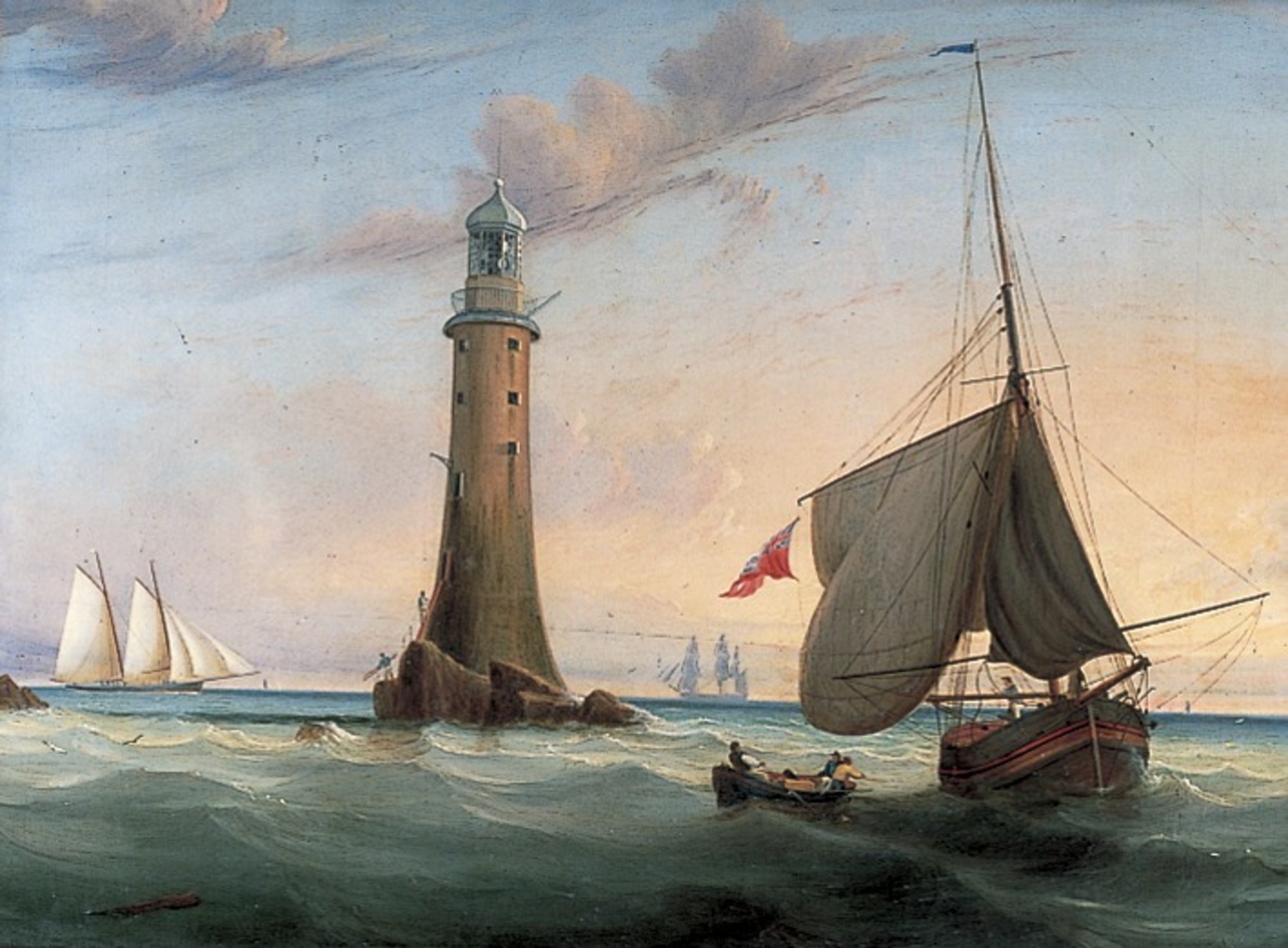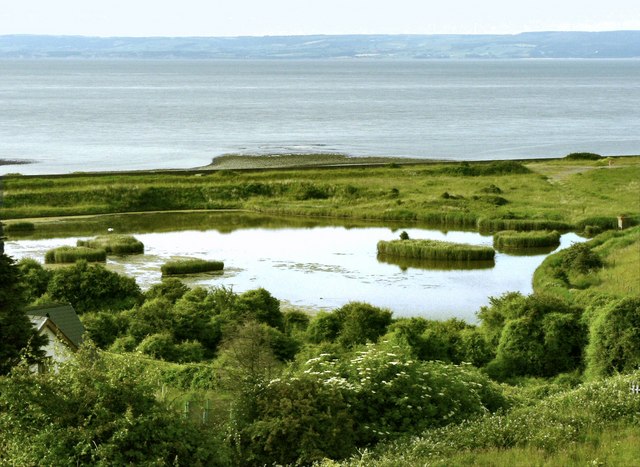|
Aberthaw Lime Works
Aberthaw Lime Works is a derelict structure, located on the South Wales coast, between Fontygary Bay and Aberthaw Power Station. The structure is a Grade II Listed Building. The structure is considered a listed building because it is a well preserved structure from an important regional industry. The Aberthaw Lime Works was opened on 22 December 1888, by the Aberthaw Pebble Limestone Company. It was built to utilise the huge number of Limestone Pebbles that had previously been taken inland or been moved by boat. The Lime Works operated until 1926. The Lime works brought a new scale of working to the lime industry which was really just a cottage industry in the area previously. The local limestone and brick structure is still largely intact, although it is missing most of its wooden components. It contains 2 vertical pot draw kilns each holding up to 300 tons each, which could produce up to 40 tons of burnt lime a day. Next to the main structure, there are 2 pot kilns which ... [...More Info...] [...Related Items...] OR: [Wikipedia] [Google] [Baidu] |
South Wales
South Wales ( cy, De Cymru) is a loosely defined region of Wales bordered by England to the east and mid Wales to the north. Generally considered to include the historic counties of Glamorgan and Monmouthshire, south Wales extends westwards to include Carmarthenshire and Pembrokeshire. In the western extent, from Swansea westwards, local people would probably recognise that they lived in both south Wales and west Wales. The Brecon Beacons National Park covers about a third of south Wales, containing Pen y Fan, the highest British mountain south of Cadair Idris in Snowdonia. A point of some discussion is whether the first element of the name should be capitalised: 'south Wales' or 'South Wales'. As the name is a geographical expression rather than a specific area with well-defined borders, style guides such as those of the BBC and ''The Guardian'' use the form 'south Wales'. In a more authoritative style guide, the Welsh Government, in their international gateway website, ... [...More Info...] [...Related Items...] OR: [Wikipedia] [Google] [Baidu] |
Aberthaw Power Station
Aberthaw Power Station refers to two decommissioned coal-fired and co-fired biomass power stations on the coast of South Wales, near Barry in the Vale of Glamorgan. They were located at Limpert Bay, near the villages of Gileston and West Aberthaw. The most recent power station on the site, Aberthaw B Power Station, co-fired biomass and as of 2008 had a generating capacity of 1,560 megawatts (MW). The power station closed on 31 March 2020. The station was the location of a carbon capture trial system to determine whether the technology could be scaled up from lab conditions. The system consumed 1 MW. History The site of the stations was a golf course before the construction of the first station. Aberthaw was constructed by the Central Electricity Generating Board (CEGB) under the chairmanship of Christopher Hinton. It is known as one of the original 'Hinton Heavies', a suite of new 500 MW units procured at the time. Aberthaw "A" Power Station altho ... [...More Info...] [...Related Items...] OR: [Wikipedia] [Google] [Baidu] |
Rhoose
Rhoose ( , cy, Y Rhws from "the moor") is a village and community near the sea (the Bristol Channel) in the Vale of Glamorgan, Wales, near Barry. The wider community includes villages and settlements such as Font-y-Gary, Penmark, East Aberthaw and Porthkerry. The population of the community in 2011 was 6,160. Description The village is the location of Cardiff Airport, formerly RAF Rhoose.About Us - Airport history Cardiff Airport. Retrieved 24 March 2016. Commercial flights began in the 1950s and control passed to Glamorgan County Council in 1965, after which date the airport expanded. The village also has a Holiday Park (Fontygary Leisure Park), some shops, a library, two |
Hydraulic Lime
Hydraulic lime (HL) is a general term for calcium oxide, a variety of lime also called quicklime, that sets by hydration. This contrasts with calcium hydroxide, also called slaked lime or air lime that is used to make lime mortar, the other common type of lime mortar, which sets by carbonation (re-absorbing carbon dioxide (CO2) from the air). Hydraulic lime provides a faster initial set and higher compressive strength than air lime, and hydraulic lime will set in more extreme conditions, including under water. The terms 'hydraulic lime' and 'hydrated lime' are quite similar and may be confused but are not necessarily the same material. Hydrated lime is any lime which has been slaked whether it sets through hydration, carbonation, or both. Calcium reacts in the lime kiln with the clay minerals to produce silicates that enable some of the lime to set through hydration. Any unreacted calcium is slaked to calcium hydroxide which sets through carbonation. These are sometimes called 's ... [...More Info...] [...Related Items...] OR: [Wikipedia] [Google] [Baidu] |
Pozzolana
Pozzolana or pozzuolana ( , ), also known as pozzolanic ash ( la, pulvis puteolanus), is a natural siliceous or siliceous- aluminous material which reacts with calcium hydroxide in the presence of water at room temperature (cf. pozzolanic reaction). In this reaction insoluble calcium silicate hydrate and calcium aluminate hydrate compounds are formed possessing cementitious properties. The designation pozzolana is derived from one of the primary deposits of volcanic ash used by the Romans in Italy, at Pozzuoli. The modern definition of pozzolana encompasses any volcanic material (pumice or volcanic ash), predominantly composed of fine volcanic glass, that is used as a pozzolan. Note the difference with the term pozzolan, which exerts no bearing on the specific origin of the material, as opposed to pozzolana, which can only be used for pozzolans of volcanic origin, primarily composed of volcanic glass. Historical use Pozzolanas such as Santorin earth were used in the Eastern Me ... [...More Info...] [...Related Items...] OR: [Wikipedia] [Google] [Baidu] |
Eddystone Lighthouse
The Eddystone Lighthouse is a lighthouse that is located on the dangerous Eddystone Rocks, south of Rame Head in Cornwall, England. The rocks are submerged below the surface of the sea and are composed of Precambrian gneiss. View at 1:50000 scale The current structure is the fourth to be built on the site. The first lighthouse (Winstanley's) was swept away in a powerful storm, killing its architect and five other men in the process. The second (Rudyard's) stood for fifty years before it burned down. The third (Smeaton's) is renowned because of its influence on lighthouse design and its importance in the development of concrete for building; its upper portions were re-erected in Plymouth as a monument. The first lighthouse, completed in 1699, was the world's first open ocean lighthouse, although the Cordouan Lighthouse off the western French coast preceded it as the first offshore lighthouse. The need for a light The Eddystone Rocks are an extensive reef approximately 12 m ... [...More Info...] [...Related Items...] OR: [Wikipedia] [Google] [Baidu] |
John Smeaton
John Smeaton (8 June 1724 – 28 October 1792) was a British civil engineer responsible for the design of bridges, canals, harbours and lighthouses. He was also a capable mechanical engineer and an eminent physicist. Smeaton was the first self-proclaimed "civil engineer", and is often regarded as the "father of civil engineering".Mark Denny (2007). "Ingenium: Five Machines That Changed the World". p. 34. JHU Press. He pioneered the use of hydraulic lime in concrete, using pebbles and powdered brick as aggregate. Smeaton was associated with the Lunar Society. Law and physics Smeaton was born in Austhorpe, Leeds, England. After studying at Leeds Grammar School he joined his father's law firm, but left to become a mathematical instrument maker (working with Henry Hindley), developing, among other instruments, a pyrometer to study material expansion. In 1750, his premises were in the Great Turnstile in Holborn. He was elected a Fellow of the Royal Society in 1753 and in 1 ... [...More Info...] [...Related Items...] OR: [Wikipedia] [Google] [Baidu] |
Watchet
Watchet is a harbour town, civil parish and electoral ward in the county of Somerset, England, with a population in 2011 of 3,785. It is situated west of Bridgwater, north-west of Taunton, and east of Minehead. The town lies at the mouth of the Washford River on Bridgwater Bay, part of the Bristol Channel, and on the edge of Exmoor National Park. The original settlement may have been at the Iron Age fort, Daw's Castle. It then moved to the mouth of the river and a small harbour developed, named by the celts as ''Gwo Coed'' meaning "under the wood". After the Saxon conquest of the area the town developed, becoming known as Weced or Waeced, and was attacked by Vikings in the 10th century. Trade using the harbour gradually grew, despite damage during several severe storms, with import and exports of goods including those from Wansbrough Paper Mill until the 19th century when it increased with the export of iron ore, brought from the Brendon Hills via the West Somerset Mineral Ra ... [...More Info...] [...Related Items...] OR: [Wikipedia] [Google] [Baidu] |
Aberthaw
Aberthaw ( cy, Aberddawan) is an area containing the villages of East Aberthaw and West Aberthaw, on the coast of South Wales about west of Barry. It is home to Aberthaw Cement Works, Aberthaw Lime Works, and Aberthaw Power Station, a coal power station that is linked to the South Wales Valleys via the Vale of Glamorgan Railway. The area is historically within the parish of Penmark in the Vale of Glamorgan. The two villages of West and East Aberthaw are separated by the River Thaw. The village of East Aberthaw, near Rhoose, has a 13th-century pub. The village Baptist Chapel and Mission Room, no longer exist as such and have been converted for other uses. Geography Aberthaw is nearly opposite to Minehead in Somerset, England. The village of East Aberthaw is situated approximately inland from the sea. The River Thaw which meets the sea at Aberthaw is fairly small and is affected by high tides at times, and with the coming of the first coal-fired power station at Aberthaw circa ... [...More Info...] [...Related Items...] OR: [Wikipedia] [Google] [Baidu] |
Aberthaw Cement Works
Aberthaw Cement Works are cement works in the Vale of Glamorgan near the village of East Aberthaw in Wales. History The Blue Lias limestone of Aberthaw was a source of hydraulic lime from early times, and it was made famous when it was selected by John Smeaton for the construction of the Eddystone Lighthouse but various records of Aberthaw Blue Lias limestone's processing are not consistent. Evidently, limestone pebbles from Aberthaw's coastline were transported inland for burning at other limekilns but much was shipped across the Bristol Channel from the Port of Aberthaw, for burning at Three Kilns, Cleeve Hill, near Watchet, Somerset. One historical account states that John Smeaton used Watchet's burned lime which was shipped to Millbay, Plymouth for his Eddystone lighthouse construction in 1756. It was not until 1888 that a (pebble) limeworks and kilns, were constructed alongside Pleasant Harbour, East Aberthaw but that works, which had become rail-served by 1892, close ... [...More Info...] [...Related Items...] OR: [Wikipedia] [Google] [Baidu] |








